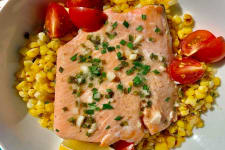
Wild Healthy New Year
December 30th, 2021A Non-Diet Inspired by Nature
January 1st can mean the start of big changes for a lot of people, especially when it comes to health. Despite our good intentions, sometimes our resolutions to live a healthier life in the new year can become overwhelmed by various trendy diets to abide by and conflicting sources of information about what’s “healthy.” Wild Alaskan Company would rather take a simpler approach by getting inspiration from nature and eating a little more wild.
How can I eat more wild?
If eating wild sounds like a foreign concept, that’s probably because it is. Most of our modern-day “foraging” happens in our grocery store carts (whether physical or digital) as we peruse aisles of food that have been curated by commercial vendors.
But even as our foraging and eating habits have been thoroughly transformed by modernization and marketing, we can still use cues from nature to eat more healthfully. The wild, healthy test is simple and uncomplicated: the more processed an ingredient, the farther it is from wild.
We aren’t exclusively advocating for wild-sourced foods, since there are very few sources of wild food that are commercially available to us — wild-caught seafood being one of them. Instead, we are advocating for nutrient-dense lean proteins, fruits, vegetables, and whole grains, which are all ingredients we can find unprocessed and close to their natural form. Sticking to these minimally processed foods and finding foolproof ways to prepare them will help us to live more wild and more healthy, not just in January but year-round.
Eating Whole Foods
There are three types of whole foods that are exceptional at keeping a wild healthy diet: lean, nutrient-dense proteins, vegetables, and whole grains.
Lean Proteins
Lean, nutrient-dense proteins are a perfect building block for a wild-inspired diet. Wild-caught fish, for instance, is one of the best types of protein a person can eat in order to stay healthy and energized throughout the year.
Wild-caught seafood, like sockeye or coho salmon, is a great source of omega-3s, a nutrient that helps keep your skin looking healthy, and can simultaneously lower your risk of chronic disease such as Alzheimer’s and rheumatoid arthritis. Omega-3s like DHA and EPA, which are only found in marine sources of food, are especially important for health as they have the potential to reduce the risk of cardiovascular disease and can even improve your circulatory system.
Vegetables
Greens, yellows, reds, and oranges — vegetables are the rainbow of nutrient-dense diets that are good for your mind, body, and soul. These beautiful, delicious gifts from nature should fill up half the plate of every meal, along with filling up your stomach!
Don’t be discouraged if you’re not an all-star chef with otherworldly knife work, because according to multiple studies, frozen veggies are just as nutritious as their fresh counterparts. Not only do they pack a nutritious punch, but frozen vegetables are also more widely available and produce less waste, making them the perfect sustainable pairing to your wild, responsibly-harvested seafood meal.
Fun fact: Clarence Birdseye (as in Birdseye frozen veggies) was the first to industrialize the flash freezing process for commercial foods. He was directly inspired by the quick-freezing tradition of fish preservation that Native Alaskans had been using for generations.
Whole Grains
The last building block of the wild healthy philosophy is whole grains. According to the American Heart Association, whole grains offer a “complete package” of nutrients, such as fiber, B-vitamins, magnesium, antioxidants, and many others. Grains such as brown rice, quinoa, farro, etc. are Mother Nature’s way of providing us with all of these benefits, and the best part is, they grow right from the ground!
Foolproof Cooking Methods
With wild-inspired whole foods as the foundation for delicious, healthy meals, the next step is to get cooking! During the entire month of January, we’ll be sharing wild and healthy recipes to help you eat closer to nature.
In the meantime, here are three foolproof cooking methods that you can use to freestyle your own delicious meals:
Baking: Baking keeps seafood moist and is a great hands off method to create a yummy meal that can serve the whole family! Baking works really well with fish such as salmon, cod, and sablefish.
Pan Frying: If you want a meal that tastes like Grandma made it, pan frying is the way to go. This cooking method is perfect for mild-tasting, flaky fish, such as halibut or a meaty shellfish like weathervane scallops. A quick tip: be sure to pat your fish dry before pan frying to get a nice sear on the outside!
Air Frying: Air frying is a relatively new, yet extremely useful kitchen appliance that takes whole foods and cooks them fast, while keeping them crispy. There are endless recipes to use in order to make a delicious, healthy meal using an air fryer, such as these extra crispy fish sticks (way healthier than store-bought).
For more wild, healthy meals, be sure to check in on Instagram, Facebook, and the Wild Alaskan Company Blog for recipes and tips throughout the entire month of January. Happy New Year and happy cooking!





